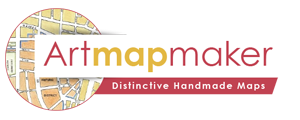
Sala dello Scudo in the Doges Palace, Venice. The Doge could ambulate the world as he viewed his commercial domain.
A map room to best them all is in the Doges Palace in Venice. The Sala dello Scudo (Hall of Shields) displays numerous large format maps and two massive globes of the world as known to the Serenissimo Principe (Serene Prince) and his cartographers. The Doge and his many electors and advisors could view their world and trade routes while enjoying the knowledge that they were the masters of what they saw (at least in a commercial sense). Today as then, a map is an art form that conveys concrete information as well as aesthetic joy.
Why do people love maps? Maps draw the viewer in with promises of visitation to places unvisited, reincarnation of moments from the past and knowledge of a place in an individual’s life. So often the comment produced by a viewer of a map is along the lines of, “I was there,” pointing to a specific spot, or, “My sister lived right here.” Maps have a unique power to bring about travel through time and space, and expand the imagination with new possibilities.

Maps Over a Couch. Great cities show themselves and evoke thoughts of past and future visits.
Maps as generally perceived are projections of part of the surface of the spherical earth onto a flat surface, inherent distortion minified by appropriate coupling of size and scale. The aesthetic beauty of maps is an intrinsic feature of their design and execution; we are taken by the scale of the presentation relative to our sensory limits to survey the earth, and held by a beguiling state of imagination and wanderlust. What better combination of experiences is there to mount on our walls? Throw in the osmotic learning of maps’ content by children who view them daily, and you have a self-propagating feature on your wall. Growing up, my sons learned every nation and its capital, and neighborhoods and byways of many major American cities, sheerly by virtue of maps I had made that hung in our home. They never once felt that they were coerced into learning, but rather sought out their encounters with Bhutan and Bamako, and a world larger than the one in which they lived.

Wall of the World. One can emulate the Serenissimo Principe and view one’s own world.
Maps have always been included in discussions of decor and design, but they seem to have reappeared cyclically of late. The rectilinear balance of maps and their complementarity to books and bookcases, artifacts and art contemporary to their vintage have welcomed maps to the inner sancta of libraries and studies. Perhaps now is a good time to bring maps out of the study and put them into broad view, on walls of staircases, in dining rooms and kitchen, in waiting rooms and offices. Hang a map, and watch your family and friends dive in, where before they didn’t even notice what was on the wall. You’ll love the comments.
Robert Tibolt is a cartographer in Las Vegas, Nevada. His work can be viewed at artmapmaker.com.
